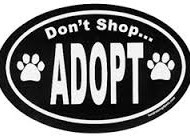Hundreds of puppies are born every day, and hundreds of adorable puppies are put to sleep in shelters across North America. We have a serious pet overpopulation problem right now. In this post we’ll share the top 10 reasons not to breed your dog.
1. Don’t breed your dogs if your goal is for any reason other than advancing the breed. Financial gain as a reason is unacceptable. Responsible breeders stand behind every puppy in their litters, ensuring that each dog has a forever home with them should they need to be returned.
2. Don’t breed if you do not have the physical and financial resources to keep every puppy—whether the litter produces one puppy or 10 puppies—in case you are unable to place them in responsible and appropriate homes.
3. Don’t breed just because your neighbor likes your dog and wants a puppy from him/her. There is no guarantee that your dog will pass its looks, temperament, or personality along to its offspring.
4. Don’t breed if you have not done the appropriate health checks on the prospective parents. Diseases are rampant in the dog world. Without the due diligence up front, you increase the odds of breeding offspring with undesirable, inheritable conditions that could have been avoided.
5. Don’t breed if you are not informed. Know the ins and outs of the type of care that both the puppies and their mother will need. Puppy care can easily take many long hours each day!
6. Don’t breed if you don’t know a thing about socialization. Puppies need introduction and exposure to household noises, children, dogs, and a variety of experiences to build the strong confidence and character that will make them good members of society.
7. Don’t breed dogs with poor temperament just because they are structurally “a good example of the breed.” Conversely, dogs that are not structurally sound will pass their physical flaws to their offspring.
8. Don’t breed if you do not realize that you are putting the life of your dog at risk. Yes, my friend, some bitches die in the process of whelping puppies, to say nothing of the fact that the puppies often die too!
9. Don’t breed just because you think it would be good “sex education” for your children. If something goes wrong, it can traumatize a child. Children can get good education from watching Animal Planet. There’s no need to put their own beloved pet at risk.
10. Don’t breed if you are willing to let your pups go to just anyone who comes along. You need to consider the lifestyle and financial resources of any prospective family and then make the appropriate match, which may include no match at all! Don’t be afraid to reject prospective adopters if they’re not qualified to be puppy parents. Good breeders take responsibility for every pup in their litters.








 During her photo shoot, she posed politely, and with each lady-like image, seemed to know that she was being captured for posterity. It was as if she knew that each photo posted on the website was a beacon to bring the right family to her.
During her photo shoot, she posed politely, and with each lady-like image, seemed to know that she was being captured for posterity. It was as if she knew that each photo posted on the website was a beacon to bring the right family to her.